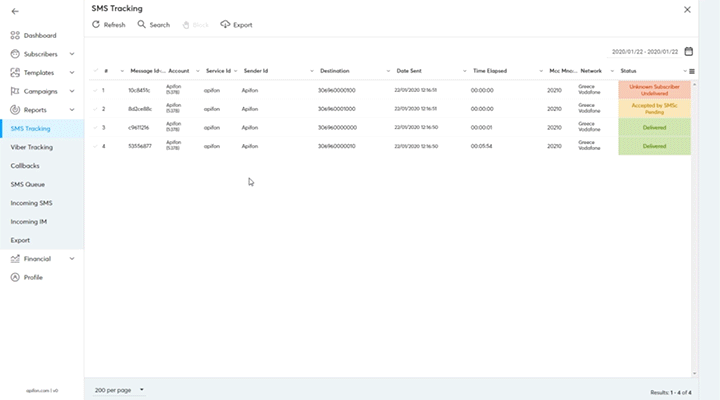Export SMS Tracking Report
In this article, we will guide you through the process of exporting an SMS tracking report on the Apifon platform.
Task Roadmap
To get started, navigate from the Dashboard to: Reports > SMS Tracking
A. Data customization
Before exporting, you can tailor the visible data by following these steps:
-
Set the time frame for your report by selecting the calendar
 at the top.
at the top. -
.Click Search in the SMS Tracking menu
![]()
or
Click the three lines (☰) icon in the upper right corner.
![]()
You can filter and customize the data using the following parameters:
-
Message ID
- Account
- Service ID
- Request ID
- Sender ID
-
Destination
- Date Sent
- Time Elapsed
- Channel
-
SMS Status
-
Countries/Network
B. Export SMS Tracking results
To export the SMS tracking results:
-
Click Export from under the SMS Tracking menu.

-
In the pop-up window, type a name for your exported file.

-
Choose the number of rows to export (select "All rows" to export everything).

-
Select the file format for export:
.xlsxor.csv.
-
The Include pivot table option is enabled by default. If you want a summary of your data in a separate Excel sheet, leave it checked; otherwise, you can uncheck it.

-
The Column names in the first row option will be enabled by default to include headers in your file.

-
Click Export.

You will receive an email notification once the file is ready for download.
Accessing Your Export
-
Navigate to the main Dashboard, then select Reports > Export.
-
Here you’ll find all previously exported files, with details such as:
-
The user who requested the export
-
Date of the export request
-
File name
-
-
Click the Download button
 to get your file.
to get your file.
Now you know how to export the SMS tracking results.
Thank you for reading!